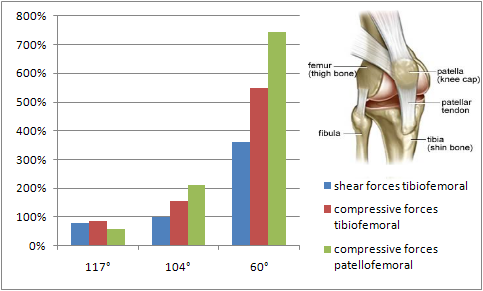Boeckh-Behrens & Buskies performed a series of research studies using data as measured by electromyography (10 male resistance-trained subjects, mean age 22y, mean body-fat 13%) for all the major and minor muscle groups of the legs. This included:
the quadriceps
the gluteus
the hamstrings
the adductors
the gastromenicus
This article will cover the quadriceps, so here is are the exercises researchers felt worked best for each quads. See if you agree.
The Quadriceps

Image 4:Inner (vastus medialis), medial
(vastus intermedius & rectus femo ris) and
outer (vastus lateralis) parts of the "quads"

Image 4:Inner (vastus medialis), medial
(vastus intermedius & rectus femo ris) and
outer (vastus lateralis) parts of the "quads"

Figure 1: Relative EMG activity of all four heads of the quadriceps during hack squat, leg press, squat and leg extension variations in comparison to barbell squatting to parallel (knee angle 75°) data adapted from Boeckh-Behrens & Buskies. 2000
1. Hack squats, lying on machine, 50° knee angle
2. Hack squats, lying on machine, 90° knee angle
3. Squats, barbell, 70° knee angle
4. 45° leg press, 90° knee angle
5. Squats, barbell, 90° knee angle
6. Squats, barbell, 40° knee angle
As you can see from figure 1, there is not really that much difference between exercises, but when you think about the amount of sheer stress caused to the patella the difference might be pretty high as see in figure 2.

Figure 2: Shear and compressive forces during squat exercise measured at different knee angles expressed as percentage of the sum of body weight + load (data adapted from a compilation in Escamilla. 2000)
So is stance or toe angle important to developing different parts of the quads? (seems like I wrote about this in Muscle and Fitness years ago)

Figure 3: Relative EMG activity of the outer part of the quadriceps (m. vastus lateralis) during barbell squat and single legged squat variations in comparison to barbell squatting to 90° knee angle data adapted from Boeckh-Behrens & Buskies. 2000
Researchers felt that when it comes to training the vastus medialis (tear drop) a slightly narrower stance may be advantageous. However, positioning of the feet pointing outward past at a 30° angle seems to be negligible (+/- 0.25%).
As for the vastus lateralis a maximal squats even to above parallel (70 degrees) is great. It seems that even with lighter weight, going below parallel starts deactivating the lateralis. Single leg exercise work the same way.
How about the medial part of the quads which include the vastus intermedius and rectus femoris?

Figure 4: Relative EMG activity of the medial part of the quadriceps (vastus intermedius & rectus femoris) during selected exercises in comparison to hack squats to a 50° knee angle data adapted from Boeckh-Behrens & Buskies. 2000
According to the data hack squat and the leg press are among the most effective exercises for the medial part of the quads. Again, angle seems to be important for results and joint safety so a 50 degree hack squat and 90 degree leg press seem to be optimal. If you are into doing cable exercises the leg kick with the cable attacked to the ankle might be an even better option, to develop the rectus femoris. Which makes sense, because this muscle also works as an extensor. This exercise is done just like you are kicking a football.